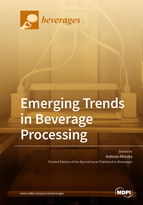Emerging Trends in Beverage Processing
A special issue of Beverages (ISSN 2306-5710).
Deadline for manuscript submissions: closed (26 February 2020) | Viewed by 51839
Special Issue Editor
Interests: food technology; enology; wine microbiology; yeast metabolomics
Special Issues, Collections and Topics in MDPI journals
Special Issue Information
Dear Colleagues,
This Special Issue is focused on new technologies to process beverages to improve the extraction from raw materials, the nutritional and sensory quality, and increase the shelf-life. Additionally, emerging technologies to analyse or control the quality of food products are of interest. Among them can be included new fermentation biotechnologies, nanotechnology, emerging physical technologies to cold-process vegetables, or milk to produce beverages. The use of cold processing technologies facilitates the extraction and improves the sensory quality of food products. Some of them are now available at an industrial scale, such as HHP, UHPH, PEF, US, MW, CP, etc.
Prof. Antonio Morata
Guest Editor
Manuscript Submission Information
Manuscripts should be submitted online at www.mdpi.com by registering and logging in to this website. Once you are registered, click here to go to the submission form. Manuscripts can be submitted until the deadline. All submissions that pass pre-check are peer-reviewed. Accepted papers will be published continuously in the journal (as soon as accepted) and will be listed together on the special issue website. Research articles, review articles as well as short communications are invited. For planned papers, a title and short abstract (about 100 words) can be sent to the Editorial Office for announcement on this website.
Submitted manuscripts should not have been published previously, nor be under consideration for publication elsewhere (except conference proceedings papers). All manuscripts are thoroughly refereed through a single-blind peer-review process. A guide for authors and other relevant information for submission of manuscripts is available on the Instructions for Authors page. Beverages is an international peer-reviewed open access quarterly journal published by MDPI.
Please visit the Instructions for Authors page before submitting a manuscript. The Article Processing Charge (APC) for publication in this open access journal is 1600 CHF (Swiss Francs). Submitted papers should be well formatted and use good English. Authors may use MDPI's English editing service prior to publication or during author revisions.
Keywords
- nanotechnology
- high hydrostatic pressure (HHP)
- ultrahigh pressure homogenization (UHPH)
- pulsed electric field (PEF)
- ultrasound (US)
- microwave (MW)
- cold plasma (CP)






